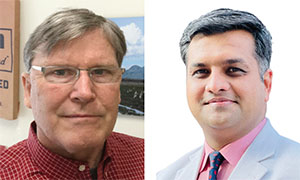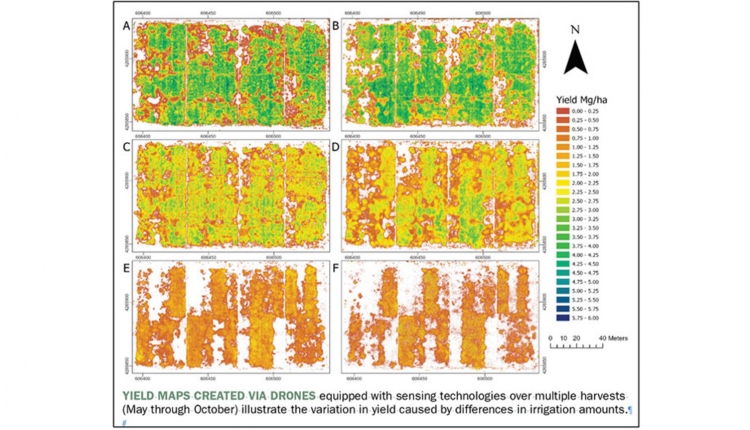Hay & Forage Grower is featuring results of research projects funded through the Alfalfa Checkoff, officially named the U.S. Alfalfa Farmer Research Initiative, administered by National Alfalfa & Forage Alliance (NAFA). The checkoff program facilitates farmer-funded research.
Alfalfa yields can vary tremendously within a field, with the highest-yielding area often three or four times that of the lowest-yielding area. Is that the result of soil limitations, fertilizers, or irrigation management? What about the effects of drought?

They also examined the use of remote sensing technology to predict alfalfa yield and quality, particularly under drought conditions. Drones or unmanned aerial vehicles equipped with multispectral and light detection and ranging (LiDAR) sensors predicted alfalfa yield “accurately,” said Putnam. They were less successful in predicting forage quality.
Drought has been a major problem for Western alfalfa growers, who have been forced to cut back on water applications. This research, like other recent studies, shows alfalfa can be successfully deficit-irrigated. In this study, alfalfa plots were treated at full or 100% evapotranspiration (ET), 60% ET (summer cutoff), 60% ET (sustained drought), or 40% ET (severe sustained drought).
Alfalfa yields were reduced under water deficits. But partial-season production totaled 70% to 98% of yields from fully watered plots over the two-year study, proving partial-season irrigations of alfalfa can be done, Gull said. Forage quality was not substantially affected by treatments.
“The question then becomes, ‘How much yield would be lost under those partial-season irrigations?’” Gull said. Measuring yield is especially challenging in deficit-irrigated or droughty fields. “We often see a patchy drought effect, where the drought shows up on the sandy patches and parts of the field that have lower water-holding capabilities. Thus, it is difficult to measure over a whole field,” he pointed out.
Drone flights were tested using different cameras or LiDAR, a technique which measures plant height. Both methods were found to be very promising, and equations proved to be fairly robust in predicting yields over a larger area.

Helps find problems
Yield prediction equations could help determine yield losses if alfalfa growers must transfer water or fields suffer from drought, Putnam said. “But one of the most useful things about imaging alfalfa fields is in diagnosing problems. In all fields, you’re going to have soil problems, damage from pests or traffic, maybe compacted soils or poor drainage, or an irrigation problem. Imaging can help you visually see the poor growth and translation to yield. If growers are not irrigating properly or are having irrigation problems, they can calculate actual yield losses in different areas, then determine if the problem is worth fixing,” he emphasized.
Sprinkler systems are used on alfalfa throughout much of the West. The researchers used LESA and MDI systems because of their high efficiency. “A lot of things can be done to improve sprinkler irrigation and LESA is one of them,” Putnam said. “It’s important to put sprinklers closer to the ground and close together to get better coverage.” Sprinklers can also convert to MDI systems, which drip water on the soil surface, reducing wind losses and allowing for slow water infiltration.
LESA and MDI are known to reduce or eliminate wind losses, improve distribution uniformity, and can push water deeper into the soil profile as compared to mid-elevation, widely spaced overhead sprinkler systems.
Project Results
1. LESA and MDI performed well. LESA sprinklers worked better with gradual deficits, and MDI performed better under sudden cutoff deficits.
2. Yields were reduced under water deficits, but partial-season yields were realized at 70% to 98% of fully watered yields depending on system and year.
3. Forage quality wasn’t greatly affected by irrigation or watering treatments.
4. Multispectral and LiDAR sensing both accurately predicted alfalfa plant height and yield. Prediction of quality was accomplished, but with less certainty.
This article appeared in the February 2023 issue of Hay & Forage Grower on pages 14-15.
Not a subscriber? Click to get the print magazine.

